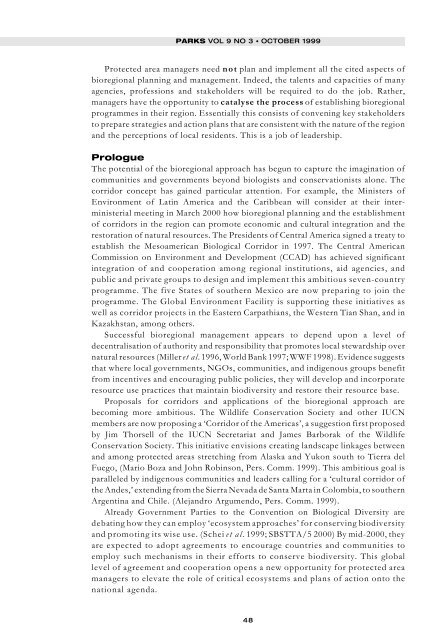Parks - IUCN
Parks - IUCN
Parks - IUCN
Create successful ePaper yourself
Turn your PDF publications into a flip-book with our unique Google optimized e-Paper software.
PARKS VOL 9 NO 3 • OCTOBER 1999<br />
Protected area managers need not plan and implement all the cited aspects of<br />
bioregional planning and management. Indeed, the talents and capacities of many<br />
agencies, professions and stakeholders will be required to do the job. Rather,<br />
managers have the opportunity to catalyse the process of establishing bioregional<br />
programmes in their region. Essentially this consists of convening key stakeholders<br />
to prepare strategies and action plans that are consistent with the nature of the region<br />
and the perceptions of local residents. This is a job of leadership.<br />
Prologue<br />
The potential of the bioregional approach has begun to capture the imagination of<br />
communities and governments beyond biologists and conservationists alone. The<br />
corridor concept has gained particular attention. For example, the Ministers of<br />
Environment of Latin America and the Caribbean will consider at their interministerial<br />
meeting in March 2000 how bioregional planning and the establishment<br />
of corridors in the region can promote economic and cultural integration and the<br />
restoration of natural resources. The Presidents of Central America signed a treaty to<br />
establish the Mesoamerican Biological Corridor in 1997. The Central American<br />
Commission on Environment and Development (CCAD) has achieved significant<br />
integration of and cooperation among regional institutions, aid agencies, and<br />
public and private groups to design and implement this ambitious seven-country<br />
programme. The five States of southern Mexico are now preparing to join the<br />
programme. The Global Environment Facility is supporting these initiatives as<br />
well as corridor projects in the Eastern Carpathians, the Western Tian Shan, and in<br />
Kazakhstan, among others.<br />
Successful bioregional management appears to depend upon a level of<br />
decentralisation of authority and responsibility that promotes local stewardship over<br />
natural resources (Miller et al. 1996, World Bank 1997; WWF 1998). Evidence suggests<br />
that where local governments, NGOs, communities, and indigenous groups benefit<br />
from incentives and encouraging public policies, they will develop and incorporate<br />
resource use practices that maintain biodiversity and restore their resource base.<br />
Proposals for corridors and applications of the bioregional approach are<br />
becoming more ambitious. The Wildlife Conservation Society and other <strong>IUCN</strong><br />
members are now proposing a ‘Corridor of the Americas’, a suggestion first proposed<br />
by Jim Thorsell of the <strong>IUCN</strong> Secretariat and James Barborak of the Wildlife<br />
Conservation Society. This initiative envisions creating landscape linkages between<br />
and among protected areas stretching from Alaska and Yukon south to Tierra del<br />
Fuego, (Mario Boza and John Robinson, Pers. Comm. 1999). This ambitious goal is<br />
paralleled by indigenous communities and leaders calling for a ‘cultural corridor of<br />
the Andes,’ extending from the Sierra Nevada de Santa Marta in Colombia, to southern<br />
Argentina and Chile. (Alejandro Argumendo, Pers. Comm. 1999).<br />
Already Government Parties to the Convention on Biological Diversity are<br />
debating how they can employ ‘ecosystem approaches’ for conserving biodiversity<br />
and promoting its wise use. (Schei et al. 1999; SBSTTA/5 2000) By mid-2000, they<br />
are expected to adopt agreements to encourage countries and communities to<br />
employ such mechanisms in their efforts to conserve biodiversity. This global<br />
level of agreement and cooperation opens a new opportunity for protected area<br />
managers to elevate the role of critical ecosystems and plans of action onto the<br />
national agenda.<br />
48

















